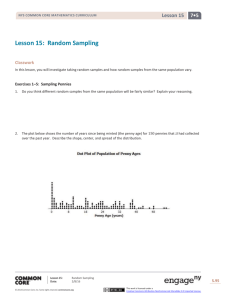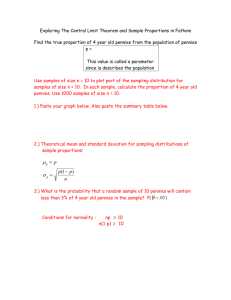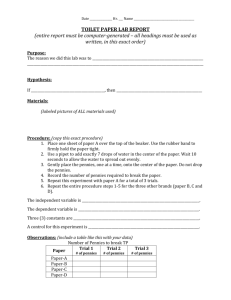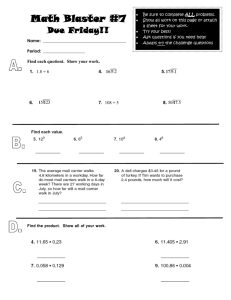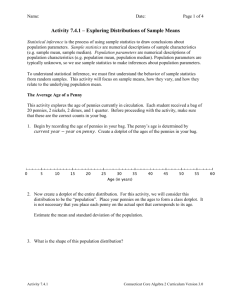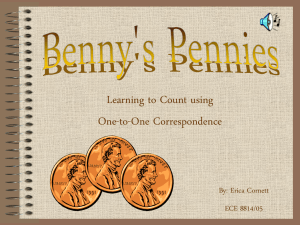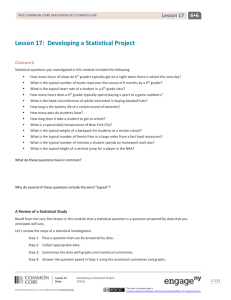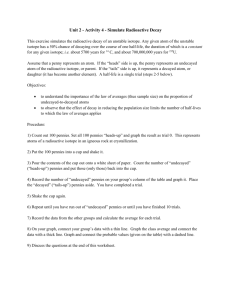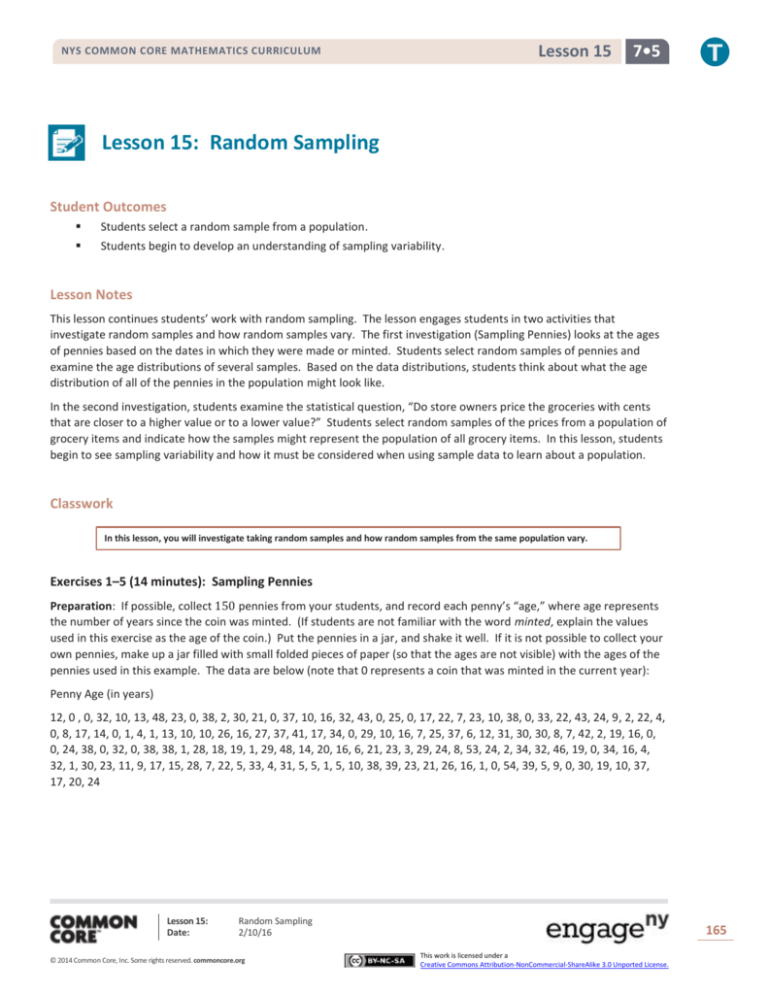
Lesson 15
NYS COMMON CORE MATHEMATICS CURRICULUM
7•5
Lesson 15: Random Sampling
Student Outcomes
Students select a random sample from a population.
Students begin to develop an understanding of sampling variability.
Lesson Notes
This lesson continues students’ work with random sampling. The lesson engages students in two activities that
investigate random samples and how random samples vary. The first investigation (Sampling Pennies) looks at the ages
of pennies based on the dates in which they were made or minted. Students select random samples of pennies and
examine the age distributions of several samples. Based on the data distributions, students think about what the age
distribution of all of the pennies in the population might look like.
In the second investigation, students examine the statistical question, “Do store owners price the groceries with cents
that are closer to a higher value or to a lower value?” Students select random samples of the prices from a population of
grocery items and indicate how the samples might represent the population of all grocery items. In this lesson, students
begin to see sampling variability and how it must be considered when using sample data to learn about a population.
Classwork
In this lesson, you will investigate taking random samples and how random samples from the same population vary.
Exercises 1–5 (14 minutes): Sampling Pennies
Preparation: If possible, collect 150 pennies from your students, and record each penny’s “age,” where age represents
the number of years since the coin was minted. (If students are not familiar with the word minted, explain the values
used in this exercise as the age of the coin.) Put the pennies in a jar, and shake it well. If it is not possible to collect your
own pennies, make up a jar filled with small folded pieces of paper (so that the ages are not visible) with the ages of the
pennies used in this example. The data are below (note that 0 represents a coin that was minted in the current year):
Penny Age (in years)
12, 0 , 0, 32, 10, 13, 48, 23, 0, 38, 2, 30, 21, 0, 37, 10, 16, 32, 43, 0, 25, 0, 17, 22, 7, 23, 10, 38, 0, 33, 22, 43, 24, 9, 2, 22, 4,
0, 8, 17, 14, 0, 1, 4, 1, 13, 10, 10, 26, 16, 27, 37, 41, 17, 34, 0, 29, 10, 16, 7, 25, 37, 6, 12, 31, 30, 30, 8, 7, 42, 2, 19, 16, 0,
0, 24, 38, 0, 32, 0, 38, 38, 1, 28, 18, 19, 1, 29, 48, 14, 20, 16, 6, 21, 23, 3, 29, 24, 8, 53, 24, 2, 34, 32, 46, 19, 0, 34, 16, 4,
32, 1, 30, 23, 11, 9, 17, 15, 28, 7, 22, 5, 33, 4, 31, 5, 5, 1, 5, 10, 38, 39, 23, 21, 26, 16, 1, 0, 54, 39, 5, 9, 0, 30, 19, 10, 37,
17, 20, 24
Lesson 15:
Date:
Random Sampling
2/10/16
© 2014 Common Core, Inc. Some rights reserved. commoncore.org
165
This work is licensed under a
Creative Commons Attribution-NonCommercial-ShareAlike 3.0 Unported License.
NYS COMMON CORE MATHEMATICS CURRICULUM
Lesson 15
7•5
In Exercise 4, students select samples of pennies. Pennies are drawn one at a time until each student has ten pennies
(without replacement). Students record the ages of the pennies and then return them to the jar. To facilitate the
sampling process, you might have students work in pairs, with one student selecting the pennies and the other recording
the ages. They could begin to draw samples when they enter the room before class begins, or they could draw samples
as the whole class works on a warm-up or review task. Put five number lines with the scale similar to the one in the plot
below on the board, document camera, or poster paper. (Note: The scale should go from 0 to 55 by fives.) If necessary,
you may need to review with students that the collection of data represents a data distribution. Data distributions were
a key part of students’ work in Grade 6 as they learned to think about shape, center, and spread.
Before students begin the exercises, ask the following: “You are going to draw a sample of 10 pennies to learn about the
population of all the pennies in the jar. How can you make sure it will be a random sample?” Make sure students
understand that as they select the pennies, they want to make sure each penny in the jar has the same chance of being
picked. Let students work with a partner on Exercises 1–4.
Exercises 1–5: Sampling Pennies
1.
MP.2
Do you think different random samples from the same population will be fairly similar? Explain your reasoning.
Most of the samples will probably be about the same because they come from the same distribution of pennies in
the jar. They are random samples, so we expect them to be representative of the population.
2.
The plot below shows the number of years since being minted (the penny age) for 𝟏𝟓𝟎 pennies that JJ had collected
over the past year. Describe the shape, center, and spread of the distribution.
The distribution is skewed with many of the pennies minted fairly recently. The minimum is 𝟎, and the maximum is
about 𝟓𝟒 years since the penny was minted. Thinking about the mean as a balance point, the mean number of years
since a penny in this population was minted seems like it would be about 𝟏𝟖 years.
3.
Place ten dots on the number line that you think might be the distribution of a sample of 𝟏𝟎 pennies from the jar.
Answers will vary. Most of the ages in the sample will be between 𝟎 and 𝟐𝟓 years. The maximum might be
somewhere between 𝟒𝟎 and 𝟓𝟒.
4.
Select a random sample of 𝟏𝟎 pennies, and make a dot plot of the ages. Describe the distribution of the penny ages
in your sample. How does it compare to the population distribution?
Answers will vary. Sample response: The median is about 𝟐𝟏 years. Two of the pennies were brand new, and one
was about 𝟓𝟒 years old. The distribution was not as skewed as I thought it would be based on the population
distribution.
Lesson 15:
Date:
Random Sampling
2/10/16
© 2014 Common Core, Inc. Some rights reserved. commoncore.org
166
This work is licensed under a
Creative Commons Attribution-NonCommercial-ShareAlike 3.0 Unported License.
Lesson 15
NYS COMMON CORE MATHEMATICS CURRICULUM
7•5
After students have thought about the relationship between their samples and the population, choose five groups to put
their dot plots on the axes you have provided. See example below.
Discuss the following question as a class:
5.
Compare your sample distribution to the sample distributions on the board.
a.
What do you observe?
Answers will vary. Sample response: Most of them seem to have the same minimum, 𝟎 years, but the
maximums vary from about 𝟑𝟓 to 𝟓𝟒 years. Overall, the samples look fairly different: One median is at 𝟐𝟓,
but several are less than 𝟏𝟎. All but two of the distributions seem to be skewed like the population (i.e., with
more of the years closer to 𝟎 than to the larger number of years).
b.
How does your sample distribution compare to those on the board?
Answers will vary. Sample response: It is pretty much the same as Sample 3, with some values at 𝟎, and the
maximum is 𝟒𝟓 years. The median is around 𝟐𝟓 years.
If time permits, you might want to have students consider sample size. After students draw a sample of ten pennies,
direct them to create a dot plot of the sample data distribution. Ask them to draw another sample of 20 pennies and
draw the data distribution of this sample. Discuss the differences. In most cases, the data distribution of the 20 pennies
will more closely resemble the population distribution.
Exercises 6–9 (23 minutes): Grocery Prices and Rounding
In the following exercises, students again select random samples from a population and use the samples to gain
information about the population to further their understanding of sampling variability.
Preparation: The following exercises investigate several facets of the cents (i.e., the 45 in $0.45) in a set of prices
advertised by a grocery store. Obtain enough flyers from a local grocery store, or from several different stores, so that
students can work in pairs. (Flyers can be found either through the local paper, the store itself, or online.) Avoid big
superstores that sell everything. We suggest using items that would typically be found in a grocery store. Have students
cut out at least 100 items advertised in the flyer with their prices and then put the slip of paper with the item and its
price in a bag. Omit items advertised as “buy two, get one free.” Students may complete this step as homework and
come to class with the items in a bag. If it is difficult to obtain a list of grocery items or to get students to prepare a list,
100 items are provided at the end of this lesson with prices based on flyers from several grocery stores in 2013.
(Students might be more interested in this activity if they are able to prepare their own grocery lists.)
Lesson 15:
Date:
Random Sampling
2/10/16
© 2014 Common Core, Inc. Some rights reserved. commoncore.org
167
This work is licensed under a
Creative Commons Attribution-NonCommercial-ShareAlike 3.0 Unported License.
Lesson 15
NYS COMMON CORE MATHEMATICS CURRICULUM
7•5
Exercises 6–9: Grocery Prices and Rounding
6.
Look over some of the grocery prices for this activity. Consider the following statistical question, “Do the store
owners price the merchandise with cents that are closer to a higher dollar value or a lower dollar value?” Describe a
plan that might answer that question that does not involve working with all 𝟏𝟎𝟎 items.
Sample response: I would place all of the items in a bag. The prices in the bag represent the population. I would
begin by selecting items from the bag and record the prices of each item I select. I would get a sample of at least 𝟏𝟎
items.
Discuss various plans suggested by students. Discuss concerns such as how the prices from the list are selected, how
many prices are selected (the sample size), and how the results are recorded. Based on the previous lesson, it is
anticipated that students will suggest obtaining random samples of the grocery items. Remind students that random
samples select items in which each item in the population has an equal chance of being selected. Also, point out to
students that the larger the sample size, the more likely it is that it will be representative of the population. The sample
size, however, should also be reasonable enough to answer the questions posed in the exercises (e.g., selecting samples
of sizes 10–25). If students select sample sizes of 50 or greater, remind them that selecting samples of that size may
take a long time. (Investigations regarding varying sample sizes will be addressed in other lessons of this module.)
To proceed with the exercises, develop a plan that all students will follow. If students are unable to suggest a workable
plan, try using the following plan. After students cut out the prices of grocery items from ads or from the suggested list,
they should shake the bag containing the slips thoroughly, draw one of the slips of paper from the bag, record the item
and its price, and set the item aside. They should then reshake the bag and continue the process until they have a
sample (without replacement) of 25 items.
If pressed for time, select a sample from one bag as a whole-class activity. To enable students to see how different
samples from the same population differ, generate a few samples of 25 items and their prices ahead of time. Display, or
hand out, summaries of these samples for the class to see. Be sure to emphasize how knowing what population your
sample came from is important in summarizing the results.
The exercises present questions that highlight how different random samples produce different results. This illustrates
the concept of sampling variability. The exercises are designed to help students understand sampling variability and why
it must be taken into consideration when using sample data to draw conclusions about a population.
7.
Do the store owners price the merchandise with cents that are closer to a higher dollar value or a lower dollar
value? To investigate this question in one situation, you will look at some grocery prices in weekly flyers and
advertising for local grocery stores.
a.
How would you round $𝟑. 𝟒𝟗 and $𝟒. 𝟗𝟗 to the nearest dollar?
$𝟑. 𝟒𝟗 would round to $𝟑. 𝟎𝟎, and $𝟒. 𝟗𝟗 would round to $𝟓. 𝟎𝟎.
b.
If the advertised price was three for $𝟒. 𝟑𝟓, how much would you expect to pay for one item?
$𝟏. 𝟒𝟓
c.
Do you think more grocery prices will round up or round down? Explain your thinking.
Sample response: Prices such as $𝟑. 𝟗𝟓 or $𝟏. 𝟓𝟗 are probably set up to round up so the store owners can get
more money.
Lesson 15:
Date:
Random Sampling
2/10/16
© 2014 Common Core, Inc. Some rights reserved. commoncore.org
168
This work is licensed under a
Creative Commons Attribution-NonCommercial-ShareAlike 3.0 Unported License.
Lesson 15
NYS COMMON CORE MATHEMATICS CURRICULUM
8.
7•5
Follow your teacher’s instructions to cut out the items and their prices from the weekly flyers, and put them in a
bag. Select a random sample of 𝟐𝟓 items without replacement, and record the items and their prices in the table
below.
(Possible responses shown in table.)
Item
grapes
peaches
melons
tomatoes
shredded cheese
bacon
asparagus
soda
ice cream
roast beef
feta cheese
mixed nuts
coffee
Price
$𝟏. 𝟐𝟖/lb.
$𝟏. 𝟐𝟖/lb.
$𝟏. 𝟔𝟗/lb.
$𝟏. 𝟒𝟗/lb.
$𝟏. 𝟖𝟖
$𝟐. 𝟗𝟗
$𝟏. 𝟗𝟗
$𝟎. 𝟖𝟖
$𝟐. 𝟓𝟎
$𝟔. 𝟒𝟗
$𝟒. 𝟗𝟗
$𝟔. 𝟗𝟗
$𝟔. 𝟒𝟗
Rounded
$𝟏. 𝟎𝟎 down
$𝟏. 𝟎𝟎 down
$𝟐. 𝟎𝟎 up
$𝟏. 𝟎𝟎 down
$𝟐. 𝟎𝟎 up
$𝟑. 𝟎𝟎 up
$𝟐. 𝟎𝟎 up
$𝟏. 𝟎𝟎 up
$𝟑. 𝟎𝟎 up
$𝟔. 𝟎𝟎 down
$𝟓. 𝟎𝟎 up
$𝟕. 𝟎𝟎 up
$𝟔. 𝟎𝟎 down
Item
paper towels
laundry soap
paper plates
caramel rolls
ground beef
sausage links
pork chops
cheese
apple juice
crackers
soda
pickles
Price
$𝟐. 𝟎𝟎
$𝟏. 𝟗𝟕
$𝟏. 𝟓𝟎
$𝟐. 𝟗𝟗
$𝟒. 𝟒𝟗/lb.
$𝟐. 𝟔𝟗/lb.
$𝟐. 𝟗𝟗/lb.
$𝟓. 𝟑𝟗
$𝟐. 𝟏𝟗
$𝟐. 𝟑𝟗
$𝟎. 𝟔𝟗
$𝟏. 𝟔𝟗
Rounded
$𝟐. 𝟎𝟎
$𝟐. 𝟎𝟎 up
$𝟐. 𝟎𝟎 up
$𝟑. 𝟎𝟎 up
$𝟒. 𝟎𝟎 down
$𝟑. 𝟎𝟎 up
$𝟑. 𝟎𝟎 up
$𝟓. 𝟎𝟎 down
$𝟐. 𝟎𝟎 down
$𝟐. 𝟎𝟎 down
$𝟏. 𝟎𝟎 up
$𝟐. 𝟎𝟎 up
Give students time to develop their answers for Exercise 9(a) individually. After a few minutes, ask students to share
their answers with the entire class. Provide a chart that displays the number of times prices were rounded up and the
number of times the prices were rounded down for each student. Also, ask students to calculate the percent of the
prices that they rounded to the higher value and display that value in the chart. As students record their results, discuss
how the results differ and what that might indicate about the entire population of prices in the bag or jar. Develop the
following conversation with students: “We know that these samples are all random samples, so we expect them to be
representative of the population. Yet, the results are not all the same. Why not?” Highlight that the differences they
are seeing is an example of sampling variability.
Example of chart suggested:
9.
Student
Number of times
prices were rounded
to the higher value
Bettina
𝟐𝟎
Percent of prices
rounded up
𝟖𝟎%
Number of times the
prices were rounded
to the lower value
𝟓
Round each of the prices in your sample to the nearest dollar, and count the number of times you rounded up and
the number of times you rounded down.
a.
Given the results of your sample, how would you answer the question: Are grocery prices in the weekly ads
at the local grocery closer to a higher dollar value or a lower dollar value?
Answers will vary. Sample response: In our sample, we found 𝟏𝟔 out of 𝟐𝟓, or 𝟔𝟒%, of the prices rounded to
the higher value, so the evidence seems to suggest that more prices are set to round to a higher dollar
amount than to a lower dollar amount.
b.
Share your results with classmates who used the same flyer or ads. Looking at the results of several different
samples, how would you answer the question in part (a)?
Answers will vary. Sample response: Different samples had between 𝟓𝟒% and 𝟕𝟎% of the prices rounded to
a higher value, so they all seem to support the notion that the prices typically are not set to round to a lower
dollar amount.
Lesson 15:
Date:
Random Sampling
2/10/16
© 2014 Common Core, Inc. Some rights reserved. commoncore.org
169
This work is licensed under a
Creative Commons Attribution-NonCommercial-ShareAlike 3.0 Unported License.
Lesson 15
NYS COMMON CORE MATHEMATICS CURRICULUM
c.
7•5
Identify the population, sample, and sample statistic used to answer the statistical question.
Answers will vary. Sample response: The population was the set of all items in the grocery store flyer or ads
that we cut up and put in the bag, the sample was the set of items we drew out of the bag, and the sample
statistic was the percent of prices that would be rounded up.
d.
Bettina says that over half of all the prices in the grocery store will round up. What would you say to her?
Answers will vary. Sample response: While she might be right, we cannot tell from our work. The population
we used was the prices in the ad or flyer. These may be typical of all of the store prices, but we do not know
because we never looked at those prices.
Closing (4 minutes)
Consider posing the following questions, and allow a few student responses for each:
Suppose everyone in class drew a different random sample from the same population. How do you think the
samples will compare? Explain your reasoning.
Answers will vary. The samples will vary with different medians, maximums, and minimums but should
have some resemblance to the population.
Explain how you know the sample of the prices of grocery store items was a random sample.
Answers will vary. To be a random sample, each different sample must have the same chance of being
selected, which means that every item has to have the same chance of being chosen. Each item in the
paper bag had the same chance of being chosen. We even shook the bag between each draw so we
wouldn’t get two that were stuck together or all the ones on the top.
Lesson Summary
In this lesson, you took random samples in two different scenarios. In the first scenario, you physically reached into
a jar and drew a random sample from a population of pennies. In the second scenario, you drew items from a bag
and recorded the prices. In both activities, you investigated how random samples of the same size from the same
population varied. Even with sample sizes of 𝟏𝟎, the sample distributions of pennies were somewhat similar to the
population (the distribution of penny ages was skewed right, and the samples all had 𝟎 as an element). In both
cases, the samples tended to have similar characteristics. For example, the samples of prices from the same store
had about the same percent of prices that rounded to the higher dollar value.
Exit Ticket (4 minutes)
Lesson 15:
Date:
Random Sampling
2/10/16
© 2014 Common Core, Inc. Some rights reserved. commoncore.org
170
This work is licensed under a
Creative Commons Attribution-NonCommercial-ShareAlike 3.0 Unported License.
Lesson 15
NYS COMMON CORE MATHEMATICS CURRICULUM
Name ___________________________________________________
7•5
Date____________________
Lesson 15: Random Sampling
Exit Ticket
Identify each as true or false. Explain your reasoning in each case.
1.
The values of a sample statistic for different random samples of the same size from the same population will be the
same.
2.
Random samples from the same population will vary from sample to sample.
3.
If a random sample is chosen from a population that has a large cluster of points at the maximum, the sample is
likely to have at least one element near the maximum.
Lesson 15:
Date:
Random Sampling
2/10/16
© 2014 Common Core, Inc. Some rights reserved. commoncore.org
171
This work is licensed under a
Creative Commons Attribution-NonCommercial-ShareAlike 3.0 Unported License.
Lesson 15
NYS COMMON CORE MATHEMATICS CURRICULUM
7•5
Exit Ticket Sample Solutions
Identify each as true or false. Explain your reasoning in each case.
1.
The values of a sample statistic for different random samples of the same size from the same population will be the
same.
False. By chance the samples will have different elements, so the values of summary statistics may be different.
2.
Random samples from the same population will vary from sample to sample.
True. Each element has the same chance of being selected, and you cannot tell which ones will be chosen; it could be
any combination.
3.
If a random sample is chosen from a population that has a large cluster of points at the maximum, the sample is
likely to have at least one element near the maximum.
True. If many of the elements are near the same value, it seems the chance of getting one of those elements in a
random sample would be high.
Problem Set Sample Solutions
The Problem Set is intended to reinforce material from the lesson and have students think about sample variation and
how random samples from the same population might differ.
1.
Look at the distribution of years since the pennies were minted from Example 1. Which of the following box plots
seem like they might not have come from a random sample from that distribution? Explain your thinking.
Sample response: Given that the original distribution had a lot of ages that were very small, the Pennies 1 sample
seems like it might not come from that population. The middle half of the ages are close together with a small
interquartile range (about 𝟏𝟐 years). The other two samples both have small values and a much larger IQR than
Pennies 1, which both seem more likely to happen in a random sample given the spread of the original data.
Lesson 15:
Date:
Random Sampling
2/10/16
© 2014 Common Core, Inc. Some rights reserved. commoncore.org
172
This work is licensed under a
Creative Commons Attribution-NonCommercial-ShareAlike 3.0 Unported License.
NYS COMMON CORE MATHEMATICS CURRICULUM
2.
Lesson 15
7•5
Given the following sample of scores on a physical fitness test, from which of the following populations might the
sample have been chosen? Explain your reasoning.
Sample response: These sample values were not in Grades 5 or 7, so the sample could not have come from those
grades. It could have come from either of the other two grades (Grades 6 or 8). The sample distribution looks
skewed like Grade 6, but the sample size is too small to be sure.
3.
Consider the distribution below:
a.
What would you expect the distribution of a random sample of size 𝟏𝟎 from this population to look like?
Sample response: The sample will probably have at least one or two elements between 𝟖𝟎 and 𝟗𝟎 and might
go as low as 𝟔𝟎. The samples will vary a lot, so it is hard to tell.
Lesson 15:
Date:
Random Sampling
2/10/16
© 2014 Common Core, Inc. Some rights reserved. commoncore.org
173
This work is licensed under a
Creative Commons Attribution-NonCommercial-ShareAlike 3.0 Unported License.
Lesson 15
NYS COMMON CORE MATHEMATICS CURRICULUM
b.
7•5
Random samples of different sizes that were selected from the population in part (a) are displayed below.
How did your answer to part (a) compare to these samples of size 𝟏𝟎?
Sample response: My description was pretty close.
c.
Why is it reasonable to think that these samples could have come from the above population?
Sample response: Each of the samples is centered about where the population is centered, although this is
easier to see with a larger sample size. The spread of each sample also looks like the spread of the
population.
d.
What do you observe about the sample distributions as the sample size increases?
Sample response: As the sample size increases, the sample distribution more closely resembles the population
distribution.
4.
Based on your random sample of prices from Exercise 6, answer the following questions:
a.
It looks like a lot of the prices end in 𝟗. Do your sample results support that claim? Why or why not?
Sample response: Using the prices in the random sample, about 𝟖𝟒% of them end in a 𝟗. The results seem to
support the claim.
b.
What is the typical price of the items in your sample? Explain how you found the price and why you chose
that method.
Sample response: The mean price is $𝟐. 𝟓𝟎, and the median price is $𝟐. 𝟎𝟎. The distribution of prices seems
slightly skewed to the right, so I would probably prefer the median as a measure of the typical price for the
items advertised.
Lesson 15:
Date:
Random Sampling
2/10/16
© 2014 Common Core, Inc. Some rights reserved. commoncore.org
174
This work is licensed under a
Creative Commons Attribution-NonCommercial-ShareAlike 3.0 Unported License.
NYS COMMON CORE MATHEMATICS CURRICULUM
5.
Lesson 15
7•5
The sample distributions of prices for three different random samples of 𝟐𝟓 items from a grocery store are shown
below.
a.
How do the distributions compare?
Sample response: The samples are slightly skewed right. They all seem to have a mean around $𝟐. 𝟓𝟎 and a
median around $𝟐. 𝟎𝟎. Sample 1 has one item that costs a lot more than the others. Most of the prices vary
from a bit less than $𝟏. 𝟎𝟎 to around $𝟓. 𝟎𝟎.
b.
Thomas says that if he counts the items in his cart at that grocery store and multiplies by $𝟐. 𝟎𝟎, he will have
a pretty good estimate of how much he will have to pay. What do you think of his strategy?
Answers will vary. Sample response: Looking at the three distributions, $𝟐. 𝟎𝟎 is about the median, so half of
the items will cost less than $𝟐. 𝟎𝟎, and half will cost more, but that will not tell you how much they cost. The
mean would be a better estimate of the total cost because the mean is calculated in a way that is similar to
how Thomas wants to estimate the total cost. In this case, the mean (or balance point) of the distributions
looks like it is about $𝟐. 𝟓𝟎, so he would have a better estimate of the total cost if he multiplied the number of
items by $𝟐. 𝟓𝟎.
Lesson 15:
Date:
Random Sampling
2/10/16
© 2014 Common Core, Inc. Some rights reserved. commoncore.org
175
This work is licensed under a
Creative Commons Attribution-NonCommercial-ShareAlike 3.0 Unported License.
Lesson 15
NYS COMMON CORE MATHEMATICS CURRICULUM
7•5
100 Grocery Items (2013 prices)
T-bone steaks
Porterhouse steaks
Pasta sauce
Ice cream cups
$6.99 (1 lb.)
$7.29 (1 lb.)
$2.19 (16 oz.)
$7.29 (6 cups)
Hot dog buns
Baking chips
Cheese chips
Cookies
$0.88 (6 buns)
$2.99 (12 oz.)
$2.09 (12 oz.)
$1.77 (15 oz.)
Kidney beans
Box of oatmeal
Soup
Chicken breasts
$0.77 (15 oz.)
$1.77 (18 oz.)
$0.77 (14 oz.)
$7.77 (1.5 lb.)
Pancake syrup
Cranberry juice
Asparagus
Seedless cucumbers
$2.99 (28 oz.)
$2.77 (64 oz.)
$3.29 (1 lb.)
$1.29 (1 ct.)
Avocado
Sliced pineapple
Box of tea
Cream cheese
$1.30 (1 ct.)
$2.99
$4.29 (16 tea bags)
$2.77 (16 oz.)
Italian roll
Turkey breast
Meatballs
Chili
$1.39 (1 roll)
$4.99 (1 lb.)
$5.79 (26 oz.)
$1.35 (15 oz.)
Peanut butter
Green beans
Apples
Mushrooms
$1.63 (12 oz.)
$0.99 (1 lb.)
$1.99 (1 lb.)
$0.69 (8 oz.)
Brown sugar
Confectioners’ sugar
Zucchini
Yellow onions
$1.29 (32 oz.)
$1.39 (32 oz.)
$0.79 (1 lb.)
$0.99 (1 lb.)
Green peppers
Mozzarella cheese
Frozen chicken
Olive oil
$0.99 (1 ct.)
$2.69 (8 oz.)
$6.49 (48 oz.)
$2.99 (17 oz.)
Dark chocolate
Cocoa mix
Margarine
Mac and cheese
$2.99 (9 oz.)
$3.33 (1 package)
$1.48 (16 oz.)
$0.66 (6 oz. box)
Birthday cake
Crab legs
Sushi rolls
Prime rib
$9.49 (7 in.)
$19.99 (1 lb.)
$12.99 (20 ct.)
$19.99 (4 lb.)
Cooked shrimp
Ice cream
Pork chops
Bananas
$12.99 (32 oz.)
$4.49 (1 qt.)
$1.79 (1 lb.)
$0.44 (1 lb.)
Chocolate milk
Beef franks
Sliced bacon
Fish fillets
$2.99 (1 gal.)
$3.35 (1 lb.)
$5.49 (1 lb.)
$6.29 (1 lb.)
Lesson 15:
Date:
Random Sampling
2/10/16
© 2014 Common Core, Inc. Some rights reserved. commoncore.org
176
This work is licensed under a
Creative Commons Attribution-NonCommercial-ShareAlike 3.0 Unported License.
Lesson 15
NYS COMMON CORE MATHEMATICS CURRICULUM
Pears
Tangerines
Orange juice
Cherry pie
$1.29 (1 lb.)
$3.99 (3 lb.)
$2.98 (59 oz.)
$4.44 (8 in.)
Grapes
Peaches
Melon
Tomatoes
$1.28 (1 lb.)
$1.28 (1 lb.)
$1.69 (1 melon)
$1.49 (1 lb.)
Shredded cheese
Soda
Roast beef
Coffee
$1.88 (12 oz.)
$0.88 (1 can)
$6.49 (1 lb.)
$6.49 (1 lb.)
Feta cheese
Pickles
Loaf of rye bread
Crackers
$4.99 (1 lb.)
$1.69 (12 oz. jar)
$2.19
$2.69 (7.9 oz.)
Purified water
BBQ sauce
Ketchup
Chili sauce
$3.47 (35 pk.)
$2.19 (24 oz.)
$2.29 (34 oz.)
$1.77 (12 oz.)
Sugar
Flour
Breakfast cereal
Cane sugar
$1.77 (5 lb.)
$2.11 (4 lb.)
$2.79 (9 oz.)
$2.39 (4 lb.)
Cheese sticks
Cheese spread
Coffee creamer
Candy bars
$1.25 (10 oz.)
$2.49 (45 oz.)
$2.99 (12 oz.)
$7.77 (40 oz.)
Pudding mix
Fruit drink
Biscuit mix
Sausages
$0.98 (6 oz.)
$1.11 (24 oz.)
$0.89 (4 oz.)
$2.38 (13 oz.)
Ground beef
Apple juice
Ice cream sandwich
Cottage cheese
$4.49 (1 lb.)
$1.48 (64 oz.)
$1.98 (12 ct.)
$1.98 (24 oz.)
Frozen vegetables
English muffins
String cheese
Baby greens
$0.88 (10 oz.)
$1.68 (6 ct.)
$6.09 (24 oz.)
$2.98 (10 oz.)
Caramel apples
Pumpkin mix
Chicken salad
Whole wheat bread
$3.11 (1 ct.)
$3.50 (1 lb.)
$0.98 (2 oz.)
$1.55 (1 loaf)
Tuna
Nutrition bar
Potato chips
2% milk
$0.98 (2.5 oz.)
$2.19 (1 bar)
$2.39 (12 oz.)
$3.13 (1 gal.)
Lesson 15:
Date:
7•5
Random Sampling
2/10/16
© 2014 Common Core, Inc. Some rights reserved. commoncore.org
177
This work is licensed under a
Creative Commons Attribution-NonCommercial-ShareAlike 3.0 Unported License.

